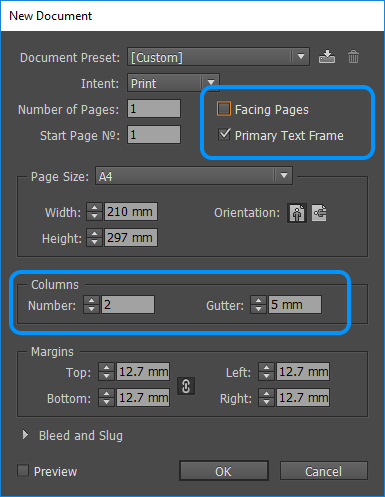

- #Add border to text frame in indesign how to
- #Add border to text frame in indesign update
- #Add border to text frame in indesign plus
(Notice that there are no running heads on the pages yet.)ĭefine the text variable the same way as for chapter numbers and chapter titles. In our sample book we call these h1 heads, shown below. Now you want to make your recto running heads show the latest internal heading of the current spread.

The Text Before field shows an en space and a quarter space, which were chosen from the drop-down list to the right of the field.
#Add border to text frame in indesign plus
Because this equals an en space plus a quarter space, the final result in the Text Before field becomes ^>^4. In this example we decided to add 3/4 of an em space between the chapter number and the chapter title. Next you’ll define the chapter title text variable for use in verso running heads just after the chapter number. Your addition will appear in the Preview box now and in your running head later on. Text Before and Text After: Add anything you like here, such as “Chapter” (plus one word space) before the number. Style: Select the name of your paragraph style for chapter numbers from the drop-down list. Type: Select the future use of the variable in this case we’re going to use it in the running heads. We used “cn” because it’s our paragraph style name for chapter numbers. The categories can be confusing, so here’s what they mean: Name: Call this text variable anything you like. You can add text before or after the number in your running heads for instance you might want to add “Chapter.” The “Type” category indicates the way you are going to use the text variable, not the kind of copy that it is now-so select Running Header (Paragraph Style). To define the chapter number as a text variable to use in your verso running head, do the following: Below you can see what a chapter opening page looks like, with our paragraph style names labels in red. We’ve developed a sample book to use for this exercise. (You may change the styles later on.) Once you’ve done that, you can define (create) the text variables, which means to set up what you want the variable to say. They don’t have to be final for now, at least assign a style name to each element. It’s simpler and less cumbersome.īefore working with text variables, set up your book’s paragraph and character styles. But with text variables, you can use A-Master for all your chapters instead, as demonstrated below.
#Add border to text frame in indesign how to
In chapter 52 of Book Design Made Simple, we explain how to create a separate master page for each chapter in your book. Adobe’s official user guide instructions on the topic of text variables are a bit sketchy, so I’ve developed a detailed lesson for you. And that’s exactly what I’m going to demonstrate in this article. They can make the current chapter number and chapter title appear-presto!-on verso pages and the most recent internal heading appear on recto pages. Now think how useful text variables could be as navigational tools (i.e., running heads) in a nonfiction book.
#Add border to text frame in indesign update
Or if you need to send readers to the last page, a text variable will automatically update the page number reference if you add or delete pages later. For instance, you could set up your document to automatically insert the current date in a header. What the heck is a text variable, anyway? It’s copy that you can add anywhere in your document-but it varies depending on the context.


 0 kommentar(er)
0 kommentar(er)
